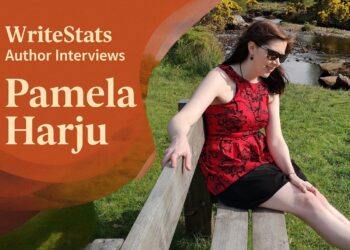In the rapidly evolving world of indie publishing, few authors embody niche mastery as clearly as Pamela Harju. Known for her signature blend of music-driven storytelling, emotional complexity, and cross-genre exploration, Harju has carved out a unique identity as a musical fiction author, a term she uses intentionally and confidently.
With nine published books, a growing multi-book series (In Time to the Music), and award-winning standalones like Sympathetic Strings and Two Hearts in a Grave, Pamela Harju has spent her career building stories where music is more than atmosphere; it’s a narrative engine. Her novels span romance, mystery, paranormal themes, and women’s fiction, yet they all share a consistent anchor: the emotional resonance of sound, performance, and artistic identity.
Because of this, Pamela Harju has become a fascinating case study in author branding, genre specialization, and indie publishing longevity. And in our recent WriteStats Author Interview Series, she offered a candid look into the habits, motivations, and challenges behind her work.
Pamela Harju: A Creative Origin Rooted in Storytelling and Sound
Like many lifelong writers, Pamela Harju’s journey began well before her first publication. As she told us:
“I was always making up stories, before I could even read or write.”
That early imaginative drive eventually merged with two lifelong influences: her love of books and her love of music. When asked what shapes her writing the most, she didn’t hesitate:
“Any book I have ever read and music.”
Music’s presence in her work isn’t superficial; it is structural. Nearly all her stories contain musicians, bands, musical tension, or artistic struggle. This connection has become her brand advantage and, as we’ve seen in genre analytics, author-owned micro-genres tend to increase reader loyalty and long-term sales.
Yet her path to publishing wasn’t linear. Harju explained that a deeply personal turning point pushed her toward releasing her work:
“My mother’s passing prompted me to start publishing.”
This combination, early imagination, musical immersion, and a life-changing push toward authorship, forms the foundation of her writing identity.
The Making of a Prolific Indie Author
Choosing Independence Over the Traditional Route
When we asked why she pursued self-publishing, Harju answered with complete clarity:
“I didn’t have the patience to search for an agent and publisher. I’d probably still be waiting!”
Pamela Harju’s publishing path reflects exactly what we uncovered in our WriteStats study, “93% of Indie Authors Are Happy They Self-Published.” Her experience reinforces the data: independence remains one of the most empowering decisions an author can make.
Harju’s nine-book catalogue reflects how that decision empowered her productivity.
She shared that she doesn’t have a publisher and works largely solo, relying on freelancers for formatting and early editing:
“Reedsy for formatting and my first editors and proofreaders. I usually buy ready-made covers.”
Her workflow is equally streamlined. She avoids rigid planning systems:
“I only plan inside my head; anything else gives me writer’s block!”
Instead, she drafts in Word and organizes details in OneNote, a minimalist system that supports her creativity rather than restricting it.
The Reality Behind the Writing Life
Despite her catalogue and accolades, Pamela Harju is refreshingly honest about authorship:
“Do you consider yourself a full-time author?”
“No.”
She clarifies that she doesn’t rely on writing income:
“Not at all. They eat into my earnings.”
This disclosure reflects a broader industry truth: most authors do not write full-time, even with multiple books on the market. Harju’s honesty contributes to more realistic expectations for emerging writers.
And when it comes to challenges, she highlights a struggle shared by 82% of surveyed indie authors (WriteStats Publishing Study, 2024):
“Marketing. It’s a nightmare, and I don’t have the time or budget to focus on it.”
Her experience underscores a critical insight: strong creative identity doesn’t automatically equal visibility; authors still need strategy, time, and systems to build momentum.
Pamela Harju on AI in Publishing
As conversations around AI reshape the publishing landscape, Harju offers a nuanced but cautious perspective:
“I am against using AI tools.”
“I guess they’ve always been there, to proofread, etc. Apart from that, I’d rather people stayed creative.”
Her distinction mirrors a pattern we’re seeing among mid-career authors: openness to functional AI (grammar, organization) but concern about creative replacement.
A Vision for the Future, and a Legacy Defined by Music
When asked what legacy she hopes to leave behind, she responded with conviction:
“I hope I will be known as the best musical fiction author to have lived.”
This ambition aligns with her publishing strategy, her thematic consistency, and her ongoing work on the In Time to the Music series, for which Book 3 is expected to be her next release:
“I have many projects, but my next release will likely be book 3 in my series.”
With niche mastery becoming increasingly valuable in the modern book market, Harju’s targeted catalogue positions her well for long-term recognition in a category she helped define.
Conclusion: Why Pamela Harju Matters in Today’s Publishing Landscape
From her early storytelling roots to her music-centred novels, Pamela Harju represents the type of author who thrives through authenticity, focus, and persistence. Her interview offers a rare glimpse into the creative and practical realities of indie publishing, from the emotional catalysts behind her writing to the challenges she continues to navigate.
And yet, through every quote, one thing is clear: Pamela Harju writes because she must.
As she put it best:
“The stories and characters only leave me alone when I write them down! I try to achieve peace and quiet inside my head.”
Writers who create for this reason tend to build bodies of work that endure, and in Harju’s case, that work is already shaping a distinct corner of modern fiction.









